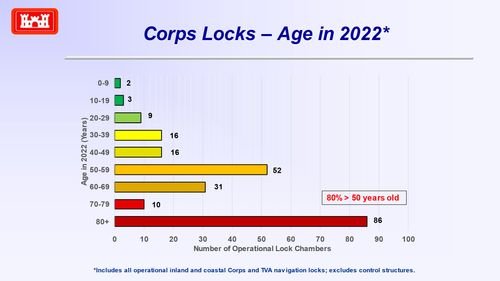In 2022, about 480 million tons of waterborne cargo transited America's inland waterways, a volume equal to roughly 14% of all intercity freight. These products, valued at over $186 billion, were shipped on the portions of our inland waterways system that generate revenue for capital improvements by a fuel user fee on commercial vessels.
Much of that tonnage travels through some of the 219 locks at 176 sites on the inland waterways system.
But the lock and dam infrastructure keeping the system moving is aging - 80% of America's locks have exceeded their engineered design life.
$16 in annual net economic benefits to the nation are generated by the Corps of Engineers’ Civil Works Mission for every $1 expended.
(Source: U.S. Army Corps of Engineers)
The House will vote on a major water infrastructure bill this week that could help combat flooding, slow coastal erosion, restore ecosystems and improve navigation at U.S. ports. The bipartisan "Water Resources Development Act of 2024" would authorize the Army Corps of Engineers to…
Read More View SourceJuly 17, 2024 Carper, Capito Legislation Invests in Water Infrastructure Projects and Programs That Will Impact All 50 states WASHINGTON, D.C. — A broad group of stakeholders has voiced support for the Thomas R. Carper Water Resources Development Act of 2024 (WRDA 2024), which advanced out…
Read More View SourceThe Senate will begin marking up annual spending bills next week, starting with three fiscal 2025 measures and overall funding totals for a dozen appropriations bills. Bypassing subcommittee markups, the full Senate Appropriations Committee will take up its Legislative Branch, Military Construction-VA…
Read MoreLOCKS AND DAMS Holt Lock Facing Months-Long Closure The Mobile Engineer District is moving closer to identifying temporary and permanent fixes to the monolith instability issue that forced an emergency closure of Holt Lock on the Black Warrior River in Tuscaloosa, Ala., June 22. Cracks…
Read More View SourceStretching 1,200 miles between Brownsville, Texas, and St. Marks, Fla., the Gulf Intracoastal Waterway (GIWW) connects many cities, including Houston, New Orleans and Mobile, Ala., and the Mississippi River and its connecting tributaries. The GIWW most adroitly serves the expansive energy and chemical…
Read More View SourceThe lockmaster and three local residents say goodbye to Monongahela River Locks and Dam 3 near Elizabeth, Pennsylvania, by plunging the handle of a blasting machine. After being in continuous operation since 1907, the U.S. Army Corps of Engineers Pittsburgh District used explosives to breach the fixed-crest…
Read More View Source

